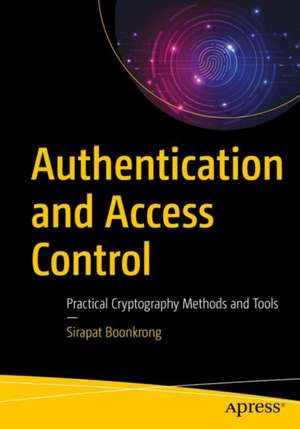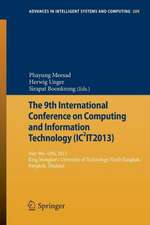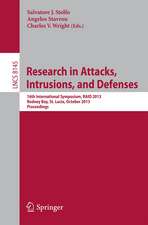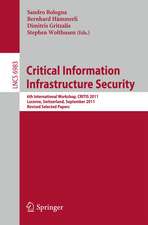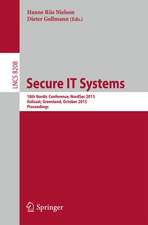Authentication and Access Control: Practical Cryptography Methods and Tools
Autor Sirapat Boonkrongen Limba Engleză Paperback – 12 dec 2020
This book begins with the theoretical background of cryptography and the foundations of authentication technologies and attack mechanisms. You will learn about the mechanisms that are available to protect computer networks, systems, applications, and general digital technologies.
Different methods of authentication are covered, including the most commonly used schemes in password protection: two-factor authentication and multi-factor authentication. You will learn how to securely store passwords to reduce the risk of compromise. Biometric authentication—a mechanism that has gained popularity over recent years—is covered, including its strengths and weaknesses.Authentication and Access Control explains the types of errors that lead to vulnerabilities in authentication mechanisms. To avoid these mistakes, the book explains the essential principles for designing and implementing authentication schemes you can use in real-world situations. Current and future trends in authentication technologies are reviewed.
What You Will Learn
- Understand the basic principles of cryptography before digging into the details of authentication mechanisms
- Be familiar with the theories behind password generation and the different types of passwords, including graphical and grid-based passwords
- Be aware of the problems associated with the use of biometrics, especially with establishing a suitable level of biometric matching or the biometric threshold value
- Study examples of multi-factor authentication protocols and be clear on the principles
- Know how to establish authentication and how key establishment processes work together despite their differences
- Be well versed on the current standards for interoperability and compatibility
- Consider future authentication technologies to solve today's problems
Who This Book Is For
Cybersecurity practitioners and professionals, researchers, and lecturers, as well as undergraduate and postgraduate students looking for supplementary information to expand their knowledge on authentication mechanisms
Preț: 303.41 lei
Preț vechi: 379.26 lei
-20% Nou
Puncte Express: 455
Preț estimativ în valută:
58.05€ • 60.62$ • 47.94£
58.05€ • 60.62$ • 47.94£
Carte disponibilă
Livrare economică 25 martie-08 aprilie
Preluare comenzi: 021 569.72.76
Specificații
ISBN-13: 9781484265697
ISBN-10: 1484265696
Pagini: 230
Ilustrații: XVII, 230 p. 63 illus.
Dimensiuni: 178 x 254 mm
Greutate: 0.48 kg
Ediția:1st ed.
Editura: Apress
Colecția Apress
Locul publicării:Berkeley, CA, United States
ISBN-10: 1484265696
Pagini: 230
Ilustrații: XVII, 230 p. 63 illus.
Dimensiuni: 178 x 254 mm
Greutate: 0.48 kg
Ediția:1st ed.
Editura: Apress
Colecția Apress
Locul publicării:Berkeley, CA, United States
Cuprins
Chapter 1: Introduction to Cryptography.- Chapter 2: Public Key Infrastructure.- Chapter 3: Methods and Threats of Authentication.- Chapter 4: Password-Based Authentication.- Chapter 5: Biometric Authentication.- Chapter 6: Multi-Factor Authentication.- Chapter 7: Authentication and Key Establishment Protocols.- Chapter 8: Current and Future Trends of Authentication.
Notă biografică
Sirapat Boonkrong has more than 15 fifteen years of experience in the field of information security as a student, researcher, and lecturer. After spending more than 10 years getting his education from high school to PhD in the UK, Sirapat began his career in 2006 as a full-time researcher at the National Electronics and Computer Technology Centre, Thailand. He then moved into full-time teaching at King Mongkut's University of Technology North Bangkok, Thailand and stayed there from 2009 to 2017. Sirapat is currently a full-time lecturer at the School of Information Technology and DIGITECH at Suranaree University of Technology, Thailand. His main teaching and research interests are in cyber security, authentication technologies, and cryptographic protocol design.
Textul de pe ultima copertă
Cybersecurity is a critical concern for individuals and for organizations of all types and sizes. Authentication and access control are the first line of defense to help protect you from being attacked.
This book begins with the theoretical background of cryptography and the foundations of authentication technologies and attack mechanisms. You will learn about the mechanisms that are available to protect computer networks, systems, applications, and general digital technologies.
Different methods of authentication are covered, including the most commonly used schemes in password protection: two-factor authentication and multi-factor authentication. You will learn how to securely store passwords to reduce the risk of compromise. Biometric authentication—a mechanism that has gained popularity over recent years—is covered, including its strengths and weaknesses.Authentication and Access Control explains the types of errors that lead to vulnerabilities in authentication mechanisms. To avoid these mistakes, the book explains the essential principles for designing and implementing authentication schemes you can use in real-world situations. Current and future trends in authentication technologies are reviewed.
You will:
Different methods of authentication are covered, including the most commonly used schemes in password protection: two-factor authentication and multi-factor authentication. You will learn how to securely store passwords to reduce the risk of compromise. Biometric authentication—a mechanism that has gained popularity over recent years—is covered, including its strengths and weaknesses.Authentication and Access Control explains the types of errors that lead to vulnerabilities in authentication mechanisms. To avoid these mistakes, the book explains the essential principles for designing and implementing authentication schemes you can use in real-world situations. Current and future trends in authentication technologies are reviewed.
You will:
- Understand the basic principles of cryptography before digging into the details of authentication mechanisms
- Be familiar with the theories behind password generation and the different types of passwords, including graphical and grid-based passwords
- Be aware of the problems associated with the use of biometrics, especially with establishing a suitable level of biometric matching or the biometric threshold value
- Study examples of multi-factor authentication protocols and be clear on the principles
- Know how to establish authentication and how key establishment processes work together despite their differences
- Be well versed on the current standards for interoperability and compatibility
- Consider future authentication technologies to solve today's problems
Caracteristici
Shows you how authentication technologies work and how they can help reduce the risks of being a victim of attacks Explains the underlying technologies of authentication mechanisms, their existing problems, and how to overcome them Presents different methods of authentication, including the most commonly used schemes in passwords, two-factor authentication, and multi-factor authentication Discusses fundamental mistakes and vulnerabilities from classic authentication protocols and the future of authentication technologies
